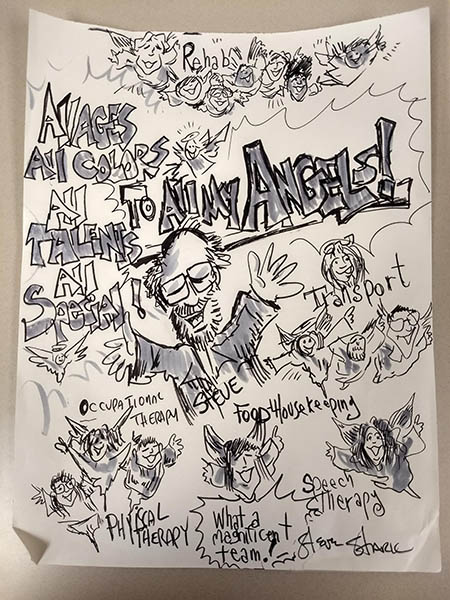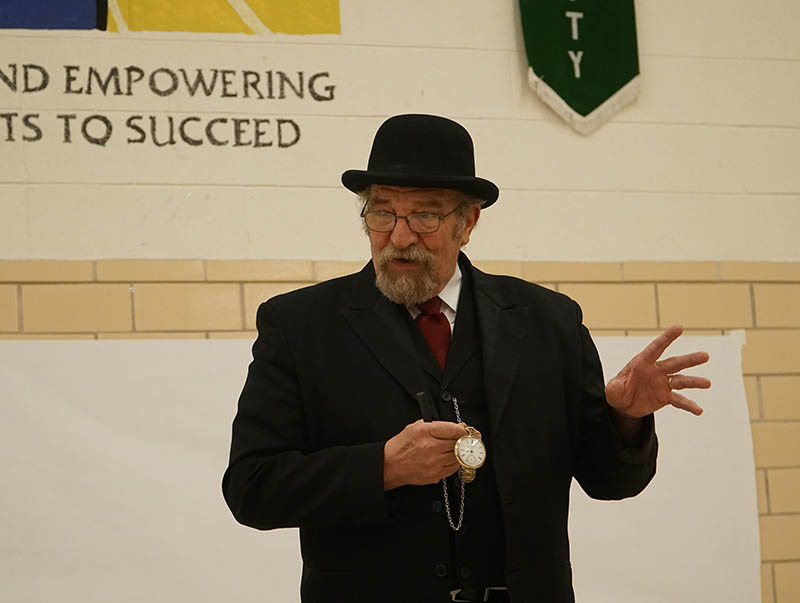Mr. History has made his comeback.
A summertime stroke forced Steve Stark to suspend his creative presentations that combine quick live charcoal sketches with storytelling.
But now Teddy Roosevelt and other historical figures are coming alive once again in the Fargo, North Dakota, region for schoolchildren and senior groups alike.
No one could be more thrilled than Stark, who might be one of the most gracious patients Sanford Health rehabilitation therapists have ever had.
“The greatest reward has been working with these wonderful, wonderful people,” Stark said. “I’m happy to be without them now, and they know that. They want the same thing. … But they are so marvelous to me and so caring and concerned.”
Stark, at 69, has a varied career behind him that has culminated most recently as newspaper political cartoonist and illustrated history presenter. But on the morning of July 15, his speaking engagements halted when his wife couldn’t wake him. He had had a stroke.
‘I wanted to be a good, good patient’
He remembers almost nothing of that day, including arriving at Sanford Medical Center Fargo, or of that evening. When his wife and family went home to sleep, Stark wasn’t able to swallow, he was shaking, and his speech made no sense.
The next morning was a different story. “When my wife came into the hospital, there I was, sitting up in bed with a nurse in the room and eating breakfast and speaking.”
After a week, he started in-patient rehab with physical, occupational and speech therapists. One serious concern for him was the loss of cognitive powers and memory. Those are key to his passion of reciting historical tales before crowds of people.
John Brown, a recreation therapist at the hospital, explained to Stark and his wife, Gwen, “Rehab 101.” He told them how rehab would work from admission to discharge and afterward.
“It’s an ongoing process,” Brown reassured them when they wondered about the timing. “And when you leave here, you’re not totally done.”
Stark committed to his inpatient and outpatient therapy. He had a lot to get back to.
“I wanted to be a good, good patient because I wanted to live. And I wanted to live as full a life as possible,” Stark said.
He warned his therapists that he would tell them, “This is terrible what you’re making me do,” and he would add a laugh. But he also told them, “Don’t get me wrong, I love being here.” And he vowed to continue working on his exercises at home.
Mr. History’s skills came back
Now, “my cognitive powers have increased a great deal,” Stark said. “I’ve gotten my language back and much of my memory, so I’ve just been very, very fortunate.”
He also feels fortunate that his stroke didn’t occur in an area of the brain that could have caused more damage. He’s still working with an occupational therapist once a week. Another area of concern was his vision — double vision, now gone; and peripheral vision, now restored. He hasn’t been cleared to drive yet but fully expects to be.
At the beginning of September, he was still using a walker, but now he can walk on his own to therapy, just eight minutes from home.
He recognizes that naps are a good thing. “I’m still very, very tired during the day, and this can last months if not a year or two,” Stark said. “But I feel great.”
He’s feeling so well that he has resumed Mr. History’s schedule of giving hourlong illustrated history presentations to classes of Fargo area kids in third, fourth and fifth grades. One session involves Stark dressed in a black frock coat, complete with vest and his great-grandfather’s pocket watch. He describes and draws pictures of people and events in the history of the Red River Valley. Another session illustrates the North Dakota segment of the Lewis and Clark Expedition.
“I was a little concerned about my memory but found that after doing so many of these programs for these young people, that I retained everything from that,” Stark said.
‘I just adore these kids’
Each year, Stark simultaneously entertains and educates thousands of students in their schools. He also presents to kids at the annual Red River Water Festival.
“I just adore these kids. They pay so much attention to Mr. History and always have,” Stark said.
He doesn’t feel tired when he’s presenting to children. “I’m more energized than anything. Exhausted at the end of the day, but absolutely energized by them,” he said.
Stark also can return to presenting at nursing homes and for other groups as well.
Brown had actually met Stark several years before, when Stark entertained the Sanford Health Brain Injury Support Group, which Brown leads.
“People were just in awe how all of a sudden these pictures just appeared by one piece of black chalk on white paper. It’s pretty impressive,” said Brown, whose work involves helping brain-injury patients adapt and return to aspects of community life.
Stark intends to go back and present in front of the group, but with a new understanding this time. “When I present again, it will be to a group of my very, very kindred spirits, as we’ve been through the same thing together,” he said.
Enlarge

(Photo by Sanford Health)
‘Grand, grand adventure’
Stark can’t remember the names of every person who helped him during his inpatient and outpatient rehab, but several come to mind.
Jessica is the occupational therapist he’s seeing now (“just wonderful”). And he found a personal connection with Missy, his physical therapist (“I can’t say enough about her”). Stark had become friends with her father while they were college freshmen in English class. He said Mark “just gave it all for that one or two hours I saw him a week.” And then, of course, there was his friend John Brown (“just this great, great guy”).
Not everyone would speak as enthusiastically about a major hospital experience as Stark, who calls it a “grand, grand adventure to have such marvelous people working on my behalf. And they do that with every single person in that unit. It’s incredible.”
As a tribute to his helpers — names known or unknown — Stark tapped his talent while still in the hospital. He created a picture of them, dedicating it to “all my angels.”
Mr. History was already starting his comeback.
Learn more
- Stroke or seizure? It can be a fine line between the two
- Strokes: 5 surprising facts about who’s at risk
- Stadium announcer loses speech, recovers from stroke
…
Posted In Brain & Spine, Emergency Medicine, Neurology, Rehabilitation & Therapy
